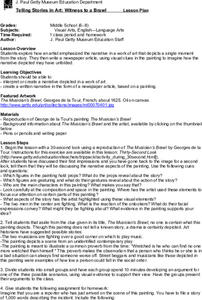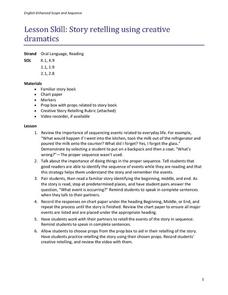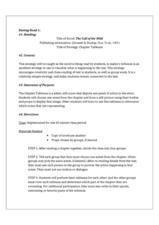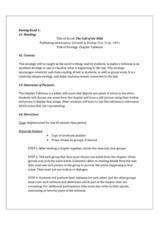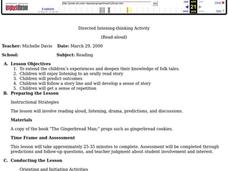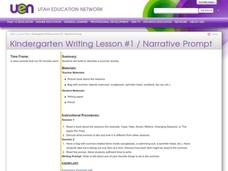Curated OER
Story Starters
Telling storyies can be a great way to learn about and identify theme. The class uses props to tell a themed story, they use masks, puppet, and costurems.
Curated OER
Story Starters
Students orally tell different types of stories using the assistance of props. For more advanced students, stories may be told according to a specific genre, or the story may have to include a given condition, setting, situation or theme.
Curated OER
Telling Stories in Art: Witness to a Brawl
Middle schoolers examine how a piece of art tells a story. In this visual art lesson, students interpret a piece of art work by writing a newspaper article that tells the story of the moment in time that is depicted in a picture. They...
Curated OER
Story Retelling Using Creative Dramatics
Doing things in the proper sequence is the focus of a solid language arts lesson. In it, pupils discuss the importance of doing things in the right order. Then, they pair off and read a short story together. They must retell the story to...
Curated OER
Write Me a Story
Second graders use the writing process and submit a story to www.kids.com. In this story writing lesson, 2nd graders choose a topic for a story contest. Students develop their stories. Students complete a her...
Curated OER
Retelling the African Folktale Abiyoyo
Act out the African folktale Abiyoyo. Kindergartners listen to the tale and discuss the characters, dressing as their favorite characters in order to retell and perform Abiyoyo using props. They will gain an understanding of...
Curated OER
Getting Adults and Children to Talk
Students engage in activities to practice their speaking skills. They role play, tell stories, use puppets and props, play games and solve puzzles. They sing songs and use rhymes to practice repetition. They read and respond to articles...
Curated OER
Telling Stories: Witness to a Brawl
Students examine Georges de la Tour's, The Musicians' Brawl and discuss the narrative elements of the painting. They write an newspaper article of what they believe they are witnessing in the painting.
Curated OER
Witness to a Brawl
Using The Musicians' Brawl, middle schoolers first impressions and the effect the title has on a piece of work. Then they analyze the narrative elements to art and write a newspaper article for the painting. In this narrative art...
Curated OER
Mrs. Wishy Washy
Learners explore the book, Mrs. Wishy Washy. They listen to the story, participate in a picture walk, identify the patterns of repeated words, role-play the motions, and retell the story using props.
Curated OER
The Woman Who Outshone the Sun
Third graders read the story "The Woman Who Outshone the Sun" from the Scott Foresman reading series. They create puppets and a setting out of a shoebox and retell the story with props. They research the Oaxaca region and the Zapotecs.
Curated OER
Walk in My Shoes: A Shoe's Perspective
Help learners write a creative story from the viewpoint of a shoe. The teacher brings a variety of different types of shoes to the classroom and each person chooses one. They then write a story from the point of view of the shoe,...
Curated OER
Chapter Tableaux: Visualizing The Call of the Wild
Do your young readers have difficulty visualizing what they read? Although the activity described here is for The Call of the Wild, the strategy could be used with any narrative. At the conclusion of each chapter of Jack London’s novel,...
Curated OER
The Call of the Wild: Activities
“There is an ecstasy that marks the summit of life” and an excitement that comes with finding a good teaching resource. Included in a richly detailed packet designed to accompany The Call of the Wild, are a tableaux exercise, a...
Curated OER
"The Clever Monkey"
Second graders complete a variety of activities related to the book "The Clever Monkey" by Rob Cleveland. They answer story comprehension questions, and rewrite the story. Students also complete a comprehension and fact or opinion...
Denver Art Museum
From the Hat’s Point of View
Here is a lesson designed for pre-schoolers and kindergartners that will pique their imaginations. They study images of a very interesting ceremonial hat from China's past called a Summer Official's Hat. These hats were worn by people of...
Curated OER
Reading
Learners are introduced to various types of folk tales. During a read-aloud, they predict what they believe is going to happen next and practice following the story line. To end the lesson, they answer comprehension questions and...
Curated OER
Storybook Theater
Tell a story visually using this resource. Learners design a storybook theater by creating a book and painting watercolor pictures describing scenes from the story. This is a creative means to have your class practice summarizing skills.
Curated OER
Narrative Prompt
Students write to describe a summer activity. They read a book about the seasons. They describe grab bag props and how they are used in summer.
Curated OER
Technology Rich Native American Unit
Student groups retell stories from Iroquois storytellers. They role-play Iroquois women, men and children and explain their roles. They read "Knots on a Counting Rope" and make up their own stories. They create timelines. They visit a...
Curated OER
KS3 Bitesize
Students complete exercises using their five senses to improve their writing skills. In this writing skills instructional activity, students complete activities blindfolded and using their five senses. Students then select an abstract...
Curated OER
Literature: Truly Fortunate Ahmed
Students gain an appreciation for Persian literature by reading "Truly Fortunate Ahmed." They select props such as turbans, rings, and clothing as they are revealed in the story. Among assessments from which students choose are:...
Curated OER
Interview for Reflection
Students practice their interviewing skills using the elements of questioning. They write and illustrate a past experience of theirs doing a philanthropic act. They share their stories and illustrations to complete the lesson.
Curated OER
Japanese Folktales
Students listen to examples of Japanese folktales and identify universal themes. Students construct a 'kamishibai' - a traditional Japanese storytelling prop - and dramatize a folktale through puppetry.


